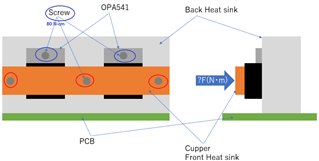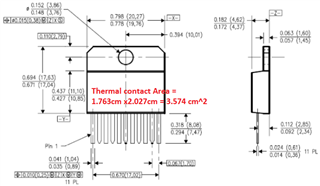Other Parts Discussed in Thread: OPA549,
Hello E2E,
Our customer has plan that attach heat sink to the back and front of the OPA541AP for heat dissipation.
Please let me know how much appropriate torque for tightening together?
Best regards,
ACGUY
This thread has been locked.
If you have a related question, please click the "Ask a related question" button in the top right corner. The newly created question will be automatically linked to this question.
Hi ACGUY,
The OPA541AP 11-pin TO-220 KV package needs to be correctly torqued down to the heat sink, The instruction below in OPA549 TO-220 will be applicable, which it has the identical package as OPA541AP.
7875.OPA549 Mounting Recommendations.pdf
If you have additional questions, please let us know.
Best,
Raymond
Hi ACGUY,
Per the torque instruction, 80 N-cm torque the screws marked in blue are good to establish the thermal bonding to the Back Heat Sink.
If you'd like to anchor additional mounting screws as shown in the image below, I would suggest the following calculation based on the OPA541's TO-220's thermal contact area (to the back of heat sink).

OPA541's tab area is approx. 3.574 cm^2. Assumed applied 80 N-cm is applied uniformly over the OPA541's thermal tab --> the applied torque per unit area is approx. 80 N-cm/3.574 = 22.38 N/cm.
If you calculate the bar's contact area in cm^2 and multiply by 22.3 N/cm, you should get the maximum applied torque on each screw, marked in red.
My concerns are the following. The heat dissipation is mainly occurred at the back of TO-220 tab. The copper bar across in front of TO-541 will dissipate some heat. In addition, by applying the above calculated torque figure may BEND the copper bar somewhat, and make a bow shaped arch in the front surface of OPA541 (I do not know how thick is Cu bar either). Therefore, you may require to consider the applied torque accordingly.
I would go with 1/3 to 1/2 of 22.3N/cm * Cu bar contacted area on OPA541 and adjust the applied torque accordingly. In addition, you may need to insert a thin thermal conductive material (e.g. high thermal conductive gasket or thermal paste etc ) underneath of the Cu bar and make a full surface contact between the two mating surfaces (encapsulated epoxy molding top surface and Cu bar).

If you have additional questions, please let me know.
Best,
Raymond
Hi ACGUY,
Will it be damaged?
Possibly. If the Cu crossmember is used as holding placement and dissipate heat from TO-220 package, then it may be ok. That is why I suggest to reduce the torque rating and increment it accordingly. The compression force on the epoxy molding is not specified anywhere and it is not used or torqued in this manner in an application.
A moderate compression force on the epoxy molding compound may be acceptable. But the purposes of the Cu crossmember are to dissipate additional heat from the surface of TO-220 package. It is not recommended to torque it down with a great force.
I am going to close this inquiry. If you have additional questions, you may still re-open this thread.
Best,
Raymond